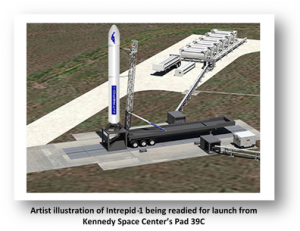
Rocket Crafters’ President & CTO, Ronald Jones, has been granted a U.S. patent was for a method for designing and fabricating flawless, high-performance, safer handling fuel grains for hybrid rocket engines using additive manufacturing technology (also known as 3D printing) which will allow the fabrication of an inherently safe and less expensive launch vehicle with only two moving parts. Jones stated that 3D printing of the rocket combustion chamber allows RCI’s expendable motors to deliver small satellites to orbits at as low as half current launch costs.
RCI is developing Intrepid-1, the world’s first mass-producible orbital launch vehicle powered by rocket engines based on the now patented technology. This most recent patent furthers RCI’s portfolio of licensed technology that now includes multiple granted patents and pending applications.
 “RCI continues to innovate. This new patent shows our commitment to making access to space safer, more reliable, and more affordable than ever before,” says former NASA astronaut and retired Sandia National Labs executive Sid Gutierrez, Chairman and CEO of RCI. “I have believed for years that hybrid rockets, due to the inherent safety when propellants are protected against accidental detonation by storing them in different states, could be the solution to make rocket powered flight as safe as airline travel one day. With our 3D printed fuel technology, we now have the means to make this a reality”.
“RCI continues to innovate. This new patent shows our commitment to making access to space safer, more reliable, and more affordable than ever before,” says former NASA astronaut and retired Sandia National Labs executive Sid Gutierrez, Chairman and CEO of RCI. “I have believed for years that hybrid rockets, due to the inherent safety when propellants are protected against accidental detonation by storing them in different states, could be the solution to make rocket powered flight as safe as airline travel one day. With our 3D printed fuel technology, we now have the means to make this a reality”.
“This revolutionary patented technology enables for the first time the use of much safer, consistent performing hybrid rocket engines to power orbital launch vehicles,” Jones said.
The patented method (US 9,453,479) uses a design and fabrication technique that is only possible using advanced 3D printing technology to boost rocket engine performance while eliminating the historical inconsistencies and sources of excessive vibration that have plagued traditionally designed hybrid rockets for decades. His patented method takes advantage of 3D printing’s unique ability to precisely fabricate fuel grains (a tubular shaped structure that dually serves as the rocket’s solid fuel source and combustion chamber) which features internal geometric patterns designed to significantly increase the amount of fuel that is available for combustion on a second-by-second basis during the rocket engine’s operation.
Commenting on his patented invention, Jones stated, “The fuel grains we are able to produce using this technology provides the structural strength needed to minimise vibration build-up while still enabling the rocket engine to consume high energy solid fuel blends at an accelerated pace”.
RCI is currently on track to incorporate their rocket motors into orbital launch vehicles in 2019.
https://youtu.be/xoBdQrHg8mk
Original published at: http://spacewatchme.com/2017/01/3d-printed-rocket-fuel-u-s-patent-granted-rci/
 SpaceWatch.Global An independent perspective on space
SpaceWatch.Global An independent perspective on space

